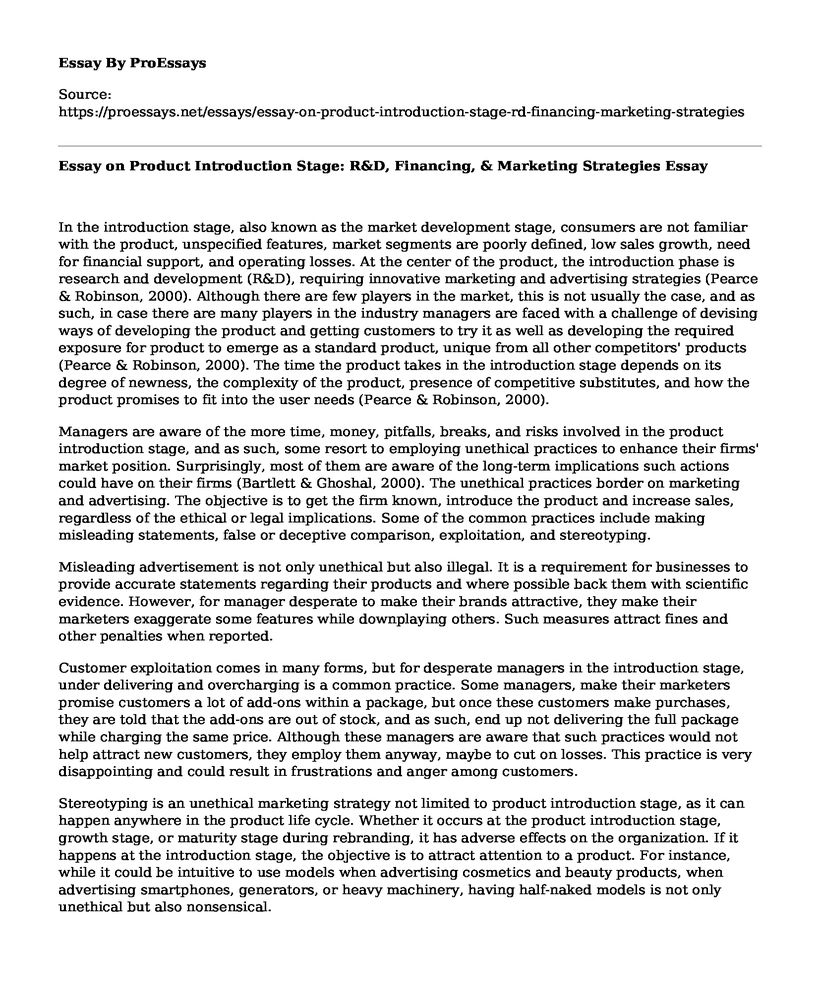In the introduction stage, also known as the market development stage, consumers are not familiar with the product, unspecified features, market segments are poorly defined, low sales growth, need for financial support, and operating losses. At the center of the product, the introduction phase is research and development (R&D), requiring innovative marketing and advertising strategies (Pearce & Robinson, 2000). Although there are few players in the market, this is not usually the case, and as such, in case there are many players in the industry managers are faced with a challenge of devising ways of developing the product and getting customers to try it as well as developing the required exposure for product to emerge as a standard product, unique from all other competitors' products (Pearce & Robinson, 2000). The time the product takes in the introduction stage depends on its degree of newness, the complexity of the product, presence of competitive substitutes, and how the product promises to fit into the user needs (Pearce & Robinson, 2000).
Managers are aware of the more time, money, pitfalls, breaks, and risks involved in the product introduction stage, and as such, some resort to employing unethical practices to enhance their firms' market position. Surprisingly, most of them are aware of the long-term implications such actions could have on their firms (Bartlett & Ghoshal, 2000). The unethical practices border on marketing and advertising. The objective is to get the firm known, introduce the product and increase sales, regardless of the ethical or legal implications. Some of the common practices include making misleading statements, false or deceptive comparison, exploitation, and stereotyping.
Misleading advertisement is not only unethical but also illegal. It is a requirement for businesses to provide accurate statements regarding their products and where possible back them with scientific evidence. However, for manager desperate to make their brands attractive, they make their marketers exaggerate some features while downplaying others. Such measures attract fines and other penalties when reported.
Customer exploitation comes in many forms, but for desperate managers in the introduction stage, under delivering and overcharging is a common practice. Some managers, make their marketers promise customers a lot of add-ons within a package, but once these customers make purchases, they are told that the add-ons are out of stock, and as such, end up not delivering the full package while charging the same price. Although these managers are aware that such practices would not help attract new customers, they employ them anyway, maybe to cut on losses. This practice is very disappointing and could result in frustrations and anger among customers.
Stereotyping is an unethical marketing strategy not limited to product introduction stage, as it can happen anywhere in the product life cycle. Whether it occurs at the product introduction stage, growth stage, or maturity stage during rebranding, it has adverse effects on the organization. If it happens at the introduction stage, the objective is to attract attention to a product. For instance, while it could be intuitive to use models when advertising cosmetics and beauty products, when advertising smartphones, generators, or heavy machinery, having half-naked models is not only unethical but also nonsensical.
While fining is viewed as a short-term implication of unethical practices, some effects are long-term. For instance, some businesses have seen their licenses suspended indefinitely. Also, firms seek to build and retain customers' trust which when it is lost at the product introduction stage, it can never be restored.
References
Bartlett, C. A., and Ghoshal, S. (2000). Going global: Lessons for late movers. Harvard Business Review, 78(2): 132-142. https://hbr.org/2000/03/going-global-lessons-from-late-movers
Pearce, J. A., and Robinson, R. B. (2000). Strategic management (7th ed.). New York: McGraw-Hill; and Dickson, op. cit., pp. 295-296.
Cite this page
Essay on Product Introduction Stage: R&D, Financing, & Marketing Strategies. (2023, Jan 29). Retrieved from https://proessays.net/essays/essay-on-product-introduction-stage-rd-financing-marketing-strategies
If you are the original author of this essay and no longer wish to have it published on the ProEssays website, please click below to request its removal:
- ERP and SCM Software Essay
- Research Paper on Goal-Setting Framework
- Context, Need, Pricing of Starbucks - Research Paper
- Paper Example on Thriving on Checklists: Balancing Critical Thinking and Creativity
- Essay Example on Launch New Cinema App: Reach Your Target Audience Effectively
- Key Resources: Vital Inputs for Value Creation - Essay Sample
- Essay Sample on Brand Positioning: Own a Conceptual Place in Customers' Minds







